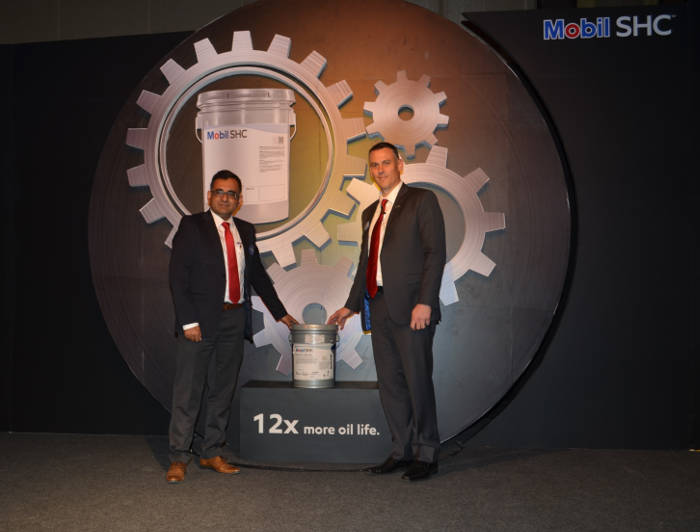Industry News
Launch of ExxonMobil’s breakthrough MOBIL SHC™ ELITE Technology

Exxon Mobil recently launched Mobil SHC™ Elite, a breakthrough synthetic gear and bearing circulating oil that is specifically engineered to deliver long lasting protection for machines operating under extreme temperatures in industries such as general manufacturing, metals, energy, and pulp and paper.
Extensive testing shows that Mobil SHC Elite can deliver 12 times the oil life of mineral oils and double the oil life of Mobil SHC 600 synthetic oils in continuous operating temperatures as high as 130°C (266°F), potentially replacing glycol-based lubricants in high temperature systems. This helps reduce the potential risk of mixing glycol-based products with incompatible mineral oils and most synthetic lubricants. Te oil also protects equipment during intermittent temperature spikes of up to 150°C (302°F) and provides up to a 3.6% energy efficiency benefit versus mineral oils.*
“Protecting advanced equipment from high in-service temperatures can be a major challenge for industrial operators, especially if that equipment is difficult to access or take offline,” said Glen Sharkowicz, Director of Brand Strategy- Commercial Marketing, South Asia Pacific, ExxonMobil Asia Pacific Pte Ltd. “With Mobil SHC Elite, equipment owners now have an advanced lubricant that can deliver much better oil life and the assurance of extra protection during high temperature excursions during peak production rates.” Following field trials, Mobil SHC Elite has been approved by Siemens for its FLENDER gear units, which depend on robust lubrication protection in rigorous operating conditions.
Mobil SHC Elite is the newest member of the Mobil SHC™ family of synthetic lubricants that provide performance advantages far exceeding the capabilities of conventional oils. Tese lubricants can help extend equipment longevity and generate potential energy savings, while their significantly longer life lowers maintenance costs and reduces worker exposure during oil changes.
Glen Sharkowicz, Director of Brand Strategy - Commercial marketing, South Asia Pacific, ExxonMobil, Asia Pacific Pte Ltd and Imtiaz Ahmed, General Manager - Marketing Deployment (Commercial marketing), ExxonMobil Lubricants Private Limited, launching Mobil SHC Elite
*Energy efficiency relates solely to the performance of Mobil SHC™ Elite Series oils when compared to conventional (mineral) reference oils of the same viscosity grade in gear applications. The technology used allows up to 3.6 percent efficiency compared to the reference when tested in a worm gearbox under controlled conditions. Efficiency improvements will vary based on operating conditions and application.
India Shifting Towards Group II Base Oils
Base oil consumption in India was 2.1 million metric tons in 2016 and is expected to rise 2.4 million tons by 2020 and 3.2 million tons by 2030. API Group II base oils are gradually gaining popularity in India and are expected to push aside Group I as the dominant grade by 2030. Group I accounted for 71 percent of the total in 2016, or 1.5 million tons, while 400,000 tons of Group II were consumed and 40,000 tons of Group III, accounting for 19 and 2 percent, respectively. By 2020, Group I consumption will slip to 1.4 million tons, Group II will inch up to 600,000 metric tons and Group III should experience a healthy bump up to 100,000 tons, said at the Asia, Middle East and Africa Base oil, Lubricants and Wax conference in Mumbai.
The shift towards more highly refined base stocks will be driven by several factors, including rising original equipment manufacturer demands for finished lubricant performance and increasingly stringent emission norms. Other factors include tougher fuel efficiency standards and advancements in lubricant additive technologies.
The lubricant market in India has been largely dominated by the automotive sector and it will continue to consume the biggest chunk of India’s lubricants market.
The volume of transportation lubes will rise from 1.1 million tons in 2016 to 1.3 million tons in 2020 and 1.8 million tons by 2030, asserted at the conference. Industrial lubricants consumption, on the other hand, will also experience healthy growth, mounting from 900,000 tons in 2018 to 1 million tons by 2020 and 1.4 million tons in 2030.
Commercial vehicles will maintain its dominance in the market, increasing from 800,000 tons in 2016 to 1 million tons, 73 percent of transportation lubes in 2016. Tat share is predicted to rise to 75 percent in 2030.
